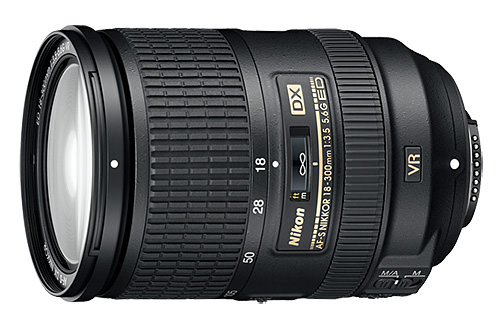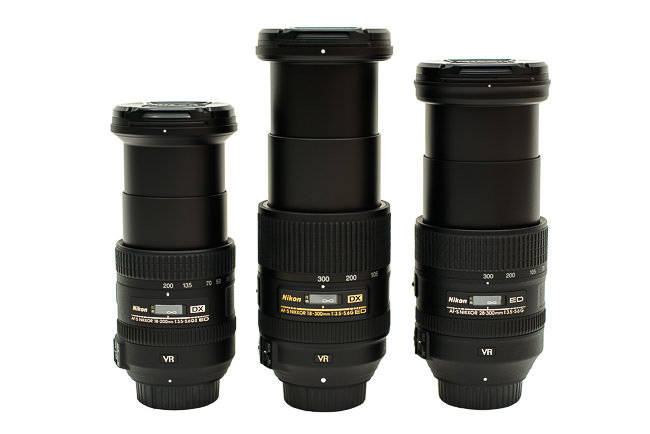Nikkor 18-300mm F/35-63g Dx Ed Vr Lens Review
This is an in-depth review of the Nikon 18-300mm f/3.v-5.6G DX ED VR lens that was released in June of 2012 along with the Nikon 24-85mm f/3.five-4.5G ED VR lens. Thanks to the popular need of the 18-200mm and the full-frame Nikon 28-300mm VR lenses, Nikon decided to add together another superzoom to the DX line.
While the 28-300mm works well on both full-frame and cropped sensor cameras, its 28mm focal length is too long for full general use on cropped sensor cameras (with an equivalent focal length of 42mm). Therefore, a redesigned version of the lens with a wider field of view makes the 18-300mm VR a more attractive superzoom option for DX users.

The Nikon eighteen-300mm DX is a variable aperture lens with a 16.7x zoom range for enthusiasts that demand a single, "all-in-one" lens for everyday and travel photography. The variable aperture of f/3.five-5.half dozen (which changes from f/iii.v on the widest terminate at 18mm to f/5.6 when zoomed in), along with the lack of the gold ring on the front of the lens indicate that the lens is not on the same level as professional-class constant aperture lenses in terms of optics, which is quite understandable, considering what it can offering in terms of zoom range.
Despite being a consumer-class lens, the Nikon 18-300mm is beefed upwardly with enough of optical technologies from Nikon. The lens sports the second generation VR II (vibration reduction) applied science, offer camera milk shake compensation equivalent to a shutter speed increase of approximately four stops, allowing to shoot at slower shutter speeds without introducing camera shake.
In addition, the two "Normal" and "Active" VR modes let photographers choose how the Vibration Reduction system responds to various shooting situations. Equipped with an AF-S silent-wave focus motor, the Nikon xviii-300mm lens focuses quietly and reasonably quickly in various lighting conditions. Similar to the 28-300mm lens, the Nikon 18-300mm too has a 77mm filter thread, which is a standard filter size on pro-level lenses, making it easy for photographers to use specialized filters (polarizing, neutral density, etc) on the lens without having to mess with adapter rings. To foreclose issues with lens creep, Nikon provided a zoom lock on the lens outside, similar to the ones on both xviii-200mm and 28-300mm lenses.

Having a like optical blueprint as the 28-300mm and the xviii-200mm lenses, the Nikon eighteen-300mm has retained a like physical appearance as well. The same barrel layout with the zoom ring in front of the lens, same focus style switches, lens markings, etc. The biggest departure is the weight and majority: the lens is the biggest and the heaviest of the iii. In this review, I will accept a closer expect at the lens, analyze its optical performance characteristics and provide comparisons to the other ii Nikon superzoom siblings.

Nikon 18-300mm f/3.5-five.6G DX ED VR Specifications
- Mount Type: Nikon F-Bayonet
- Focal Length Range: 18-300mm
- Zoom Ratio: sixteen.7x
- Maximum Aperture: f/iii.5
- Minimum Aperture: f/22
- Format: DX
- Maximum Angle of View (DX-format): 76°
- Minimum Bending of View (DX-format): 5°twenty′
- Maximum Reproduction Ratio: 0.32x
- Lens Elements: 19
- Lens Groups: 14
- Optical Conversion Cistron: 1.5x
- Compatible Format(southward): DX
- VR (Vibration Reduction)/Image Stabilization: Yes
- Diaphragm Blades: 9
- Distance Information: Yes
- ED Drinking glass Elements: 3
- Aspherical Elements: 3
- Super Integrated Coating: Yes
- Autofocus: Aye
- AF-S (Silent Wave Motor): Yep
- Internal Focusing: Yes
- Minimum Focus Distance: 1.48 ft. (0.45m) merely at 300mm zoom setting
- Focus Mode: AF, Manual
- Thousand-type: Yes
- Filter Size: 77mm
- Accepts Filter Type: Screw-on
- Dimensions (Approx.): 3.3×4.seven in. (Diameter x Length) 83x120mm (Bore 10 Length)
- Weight (Approx.): 29.3 oz. (830g)
- Supplied Accessories: HB-58 Bayonet Lens Hood, LC-77 Snap-on Front Lens Cap, LF-four Rear Lens Cap, CL-1120 Soft Example
Detailed specifications for the lens, along with MTF charts and other useful information tin can be plant in our lens database.

Lens Construction and Handling
As I have already pointed out in the introduction of this review, the Nikon xviii-300mm is bigger and heavier than both the 18-200mm and the 28-300mm lenses. And for this reason lonely, information technology was one of the first things that I really disliked nigh it. Aye, the 18-300mm does give more range than whatever other Nikkor lens, but it is a DX lens and it feels completely out of remainder on near DX cameras. When fully extended, information technology gets so long that from the side information technology about looks similar you are using the seventy-200mm f/two.8. The Nikon 18-200mm at present looks small in comparing and it is not a small lens to first with. Weighing 830 grams, it is a whopping 270 grams heavier than the 18-200mm – about as heavy as the Nikon 24-70mm f/ii.8G! I don't know what Nikon was thinking when they designed the lens – what kind of a DX shooter would want this monstrosity? I can understand if one desires a heavy and expensive lens for performance reasons, only the 18-300mm is not a very abrupt lens. And so keeping its performance characteristics in mind, it is too beefy and heavy in my opinion. Some people prefer DX cameras for weight reasons, so I guess the 18-300mm would be completely out of question for those folks.
Here is how the lens compares to the eighteen-200mm and 28-300mm size-wise (From left to right: Nikon 18-200mm, Nikon 18-300mm, Nikon 28-300mm):

And hither they all are once again, this fourth dimension fully extended (From left to right: Nikon 18-200mm, Nikon 18-300mm, Nikon 28-300mm):

On a positive annotation, the lens is built well and feels solid in hands – certainly ameliorate than the Tamron and Sigma equivalents. Information technology has a plastic barrel with plastic focus and zoom rings (the zoom ring is covered with condom). Most of the recently-announced lenses past Nikon have a plastic exterior, which does not necessarily mean that the lenses are not solid. The interior of the Nikon eighteen-300mm contains plenty of metal to concord optical elements, although judging from the weight, it feels like the lens has nothing but glass. The lens mount is also made of solid metallic, non plastic equally in some cheap kit lenses like eighteen-55mm DX.
The Nikon 18-300mm DX should be able to withstand cold and hot temperatures, but I would not leave it under pelting, farthermost moisture and dusty environments. The lens is almost vulnerable when zoomed in – the butt extends out quite a bit and any grit that settles on the lens butt can be chop-chop sucked into the lens, resulting in dust inside the lens and potentially on the camera sensor. While dust specs generally do not impact the sharpness of a lens, also much dust decreases lens contrast, resulting in images that look a fiddling cloudier than normal. Annotation that most zoom lenses are prone to the same outcome as above, including some of the professional person lenses.
The zoom ring is easy to rotate from xviii to 300mm and vice versa, although it felt a little strong at first when I started using it. Zooming in/out got a little smoother overtime, but not too much to cause the lens to creep. It takes more than a half turn to go from 18 to 300mm, which means you can zoom to a subject very quickly.
Another important thing to note is that the front role of the lens does not seem to wobble when the lens is fully extended (the 18-200mm is notorious for that). The plastic focus ring is located on the back of the lens, which I detect backwards. I am used to the zoom band being close to the photographic camera and the focus ring to be in the front end. Merely if y'all take shot with the 18-200mm or other DX lenses like Nikon 18-105mm or Nikon xviii-135mm, you should accept no problems with this.

Autofocus Speed and Accuracy
The autofocus motor of the Nikon 18-300mm f/3.5-5.6G VR is quiet and authentic at short focal lengths, even in low-light atmospheric condition, thank you to the AF-S Silent Wave Motor. Autofocus speed is relatively quick, simply certainly not as fast as in pro-level lenses. As you zoom in, however, autofocus accuracy is inconsistent and tin be all over the identify – with plenty of hits and misses. Anything higher up 105mm tends to miss focus and it gets worse at 200mm and 300mm. With such a complex lens blueprint, I can see why it is so weak on the telephoto side.
Because the optical performance of the lens is rather weak at the telephoto end, and since in that location is a meaning amount of light loss at f/v.vi, the phase-detect sensor oftentimes gets dislocated and gives faux positives. Well, that's what you lot become with a superzoom. Focus tracking is OK in continuous mode, again just at brusque focal lengths. When the lens cannot autofocus and starts to hunt, the autofocus operation gets to a itch speed. I was able to get a couple of precipitous shots at 300mm, just it was non easy. I had to constantly refocus and have pictures and eventually got a couple of keepers. Hither is an prototype sample of a Black Comport photographed at 300mm:

It does non look bad when the image is down-sampled. Only at 100% view, it is non as impressive. If you are after wild animals, this lens is clearly not a proficient candidate – yous would be much better off with the lxx-300mm lens.
genovesedresseppy.blogspot.com
Source: https://photographylife.com/reviews/nikon-18-300mm-vr
0 Response to "Nikkor 18-300mm F/35-63g Dx Ed Vr Lens Review"
Enregistrer un commentaire